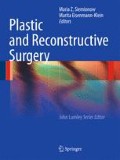Summary
Congenital breast deformities pose a challenging dilemma in plastic surgery. The expression of the abnormality may be complete, and anatomic components are often missing, deformed, or weakened. Most breasts are naturally asymmetrical. These asymmetries may include discrepancies in breast size and shape, location of the nipple–areola complex, the inframammary fold, or skeletal abnormalities (see Figure 29.1). Breast abnormalities can cause emotional and psychological trauma, resulting in social maladjustment and associated behavioral problems. The majority of patients are young healthy individuals who seek aesthetic restoration of their deformities.
Preoperative evaluation begins with a thorough medical and surgical history, particularly related to breast disease. Physical examination includes identification of chest wall or musculoskeletal deformities; shape, symmetry, and volume of both breasts; the presence and degree of ptosis; the position of the inframammary folds; and anomalies of the nipple—areola complex. Most of these anomalies require a multistage surgical approach, and the patient must be extensively counseled.
Access this chapter
Tax calculation will be finalised at checkout
Purchases are for personal use only
Abbreviations
- DIEP:
-
Deep inferior epigastric perforator flap
- LDF:
-
Latissimus dorsi muscle myocutaneous flap
- SGAP:
-
Superior gluteal artery perforator flap
- TRAM:
-
Transverse rectus abdominis myocuta-neous flap
References
Bhatnagar K P, Ramsaroop L, Bhatnagar KP, Satyapal KS, Singh B. Dorsal scapular breast in a woman. Plast Reconstr Surg. 2003;112:571–574.
Bland KI, Copeland EM. The Breast: Comprehensive Management of Benign and Malignant Disorders. 3rd ed. Philadelphia, PA: Elsevier 2004.
Borschel GH, Izenberg PH, Cederna PS. Endoscopically assisted reconstruction of male and female Poland syndrome. Plast Reconstr Surg. 2002;109:1536–1543.
Choupina M, Malheiro E, Pinho C, et al. Tuberous breast: a surgical challenge. Aesthet Plast Surg. 2002;26:50–53.
Emsen IM. Treatment with ultrasound-assisted liposuc-tion of accessory axillary breast tissues. Aesthet Plast Surg. 2006;30:251–252.
Evans DM, Guyton DP. Carcinoma of the axillary breast. J Surg Oncol. 1995;59:190–195.
Fokin AA, Robicsek F. Poland's syndrome revisited. Ann Thorac Surg. 2002;74:2218–2225.
Freire-Maia N, Chautard EA, Opitz JM, Freire-Maia A, Quelce-Salgado A. The Poland syndrome-clinical and genealogical data, dermatoglyphic analysis, and incidence. Hum Hered. 1973;23:97–104.
Gautam AK, Allen RJ Jr, LoTempio MM, et al. Congenital breast deformity reconstruction using perforator flaps. Ann Plast Surg. 2007;58:353–358.
Gill PS, Hunt JP, Guerra AB, et al. A 10-year retrospective review of 758 DIEP flaps for breast reconstruction. Plast Reconstr Surg. 2004;113:1153–1160.
Goedert JJ, McKeen EA, Javadpour N, Ozols RF, Pottern LM, Fraumeni JF Jr. Polythelia and testicular cancer. Ann Intern Med. 1984;101:646–647.
Grolleau JL, Lanfrey E, Lavigne B, Chavoin J P, Costagliola M. Breast base anomalies: treatment strategy for tuberous breasts, minor deformities, and asymmetry. Plast Reconstr Surg. 1999;104:2040–2048.
Liao HT, Cheng MH, Ulusal BG, Wei FC. Deep inferior epigastric perforator flap for successful simultaneous breast and chest wall reconstruction in a Poland anomaly patient. Ann Plast Surg. 2005;55:422–426.
Longaker MT, Glat PM, Colen LB, Siebert JW. Reconstruction of breast asymmetry in Poland's hest-wall deformity using microvascular free flaps. Plast Reconstr Surg. 1997;99:429–436.
Maillard GF. A Z-mammaplasty with minimal scarring. Plast Reconstr Surg. 1986;77:66–76.
Marks MW, Argenta LC, Izenberg PH, Mes LG. Management of the chest-wall deformity in male patients with Poland's syndrome. Plast Reconstr Surg. 1991;87:674–678; discussion 679–681.
May JW Jr, Lukash FN, Gallico GG III. Latissimus dorsi harvest for free and pedicled tissue transfer. In: Bostwick J, Felmont FE, Nahai F, Barrows S, eds. Endoscopic Plastic Surgery St Louis, MO: Quality Medical Publishing. 1995.
Parker DL, Mitchell PR, Holmes GL. Poland—Mobius syndrome. J Med Genet. 1981;18:317–320.
Puckett CL, Concannon MJ. Augmenting the narrow-based breast: the unfurling technique to prevent the double-bubble deformity. Aesthet Plast Surg. 1990;14:15–19.
Rees TD, Aston SJ. The tuberous breast. Clin Plast Surg. 1976;3:339–347.
Ribeiro L, Canzi W, Buss A Jr, Accorsi A Jr. Tuberous breast: a new approach. Plast Reconstr Surg. 1998;101:42–50; discussion 51–42.
Schmidt H. Supernumerary nipples: prevalence, size, sex and side predilection — a prospective clinical study. Eur J Pediatr. 1998;157:821–823.
Trier WC. Complete breast absence. Case report and review of the literature. Plast Reconstr Surg. 1965;36:431–439.
Tvrdek M, Kletensky J, Svoboda S. Aplasia of the breast-reconstruction using a free tram flap. Acta Chir Plast. 2001;43:39–41.
Velanovich V. Ectopic breast tissue, supernumerary breasts, and supernumerary nipples. S Med J. 1995;88:903–906.
von Heimburg D, Exner K, Kruft S, Lemperle G. The tuberous breast deformity: classification and treatment. Br J Plast Surg. 1996;49:339–345.
Author information
Authors and Affiliations
Editor information
Editors and Affiliations
Rights and permissions
Copyright information
© 2010 Springer-Verlag London Limited
About this chapter
Cite this chapter
Lucas, A., Nasir, S. (2010). Congenital Breast Malformations. In: Siemionow, M.Z., Eisenmann-Klein, M. (eds) Plastic and Reconstructive Surgery. Springer Specialist Surgery Series. Springer, London. https://doi.org/10.1007/978-1-84882-513-0_29
Download citation
DOI: https://doi.org/10.1007/978-1-84882-513-0_29
Publisher Name: Springer, London
Print ISBN: 978-1-84882-512-3
Online ISBN: 978-1-84882-513-0
eBook Packages: MedicineMedicine (R0)

